The Impact of Stress on Wound Healing: An Empirical Essay (PSY224)
VerifiedAdded on 2023/01/19
|7
|1956
|37
Essay
AI Summary
This essay critically evaluates the relationship between stress and wound healing, using empirical evidence to explain the impact of psychological stress on the body's ability to heal. The introduction provides an overview of the factors influencing wound healing and highlights the detrimental effects of stress. The discussion delves into the physiological mechanisms, including the role of cortisol and the immune system, and provides evidence from research journals. The essay uses a case study of Martha, a flower shop owner, to illustrate the effect of stress on wound healing. Furthermore, it explores ways Martha could improve her wound healing times by managing her stress through techniques like meditation, exercise, and a healthy lifestyle. The conclusion summarizes the key findings and emphasizes the importance of stress management for effective wound healing.
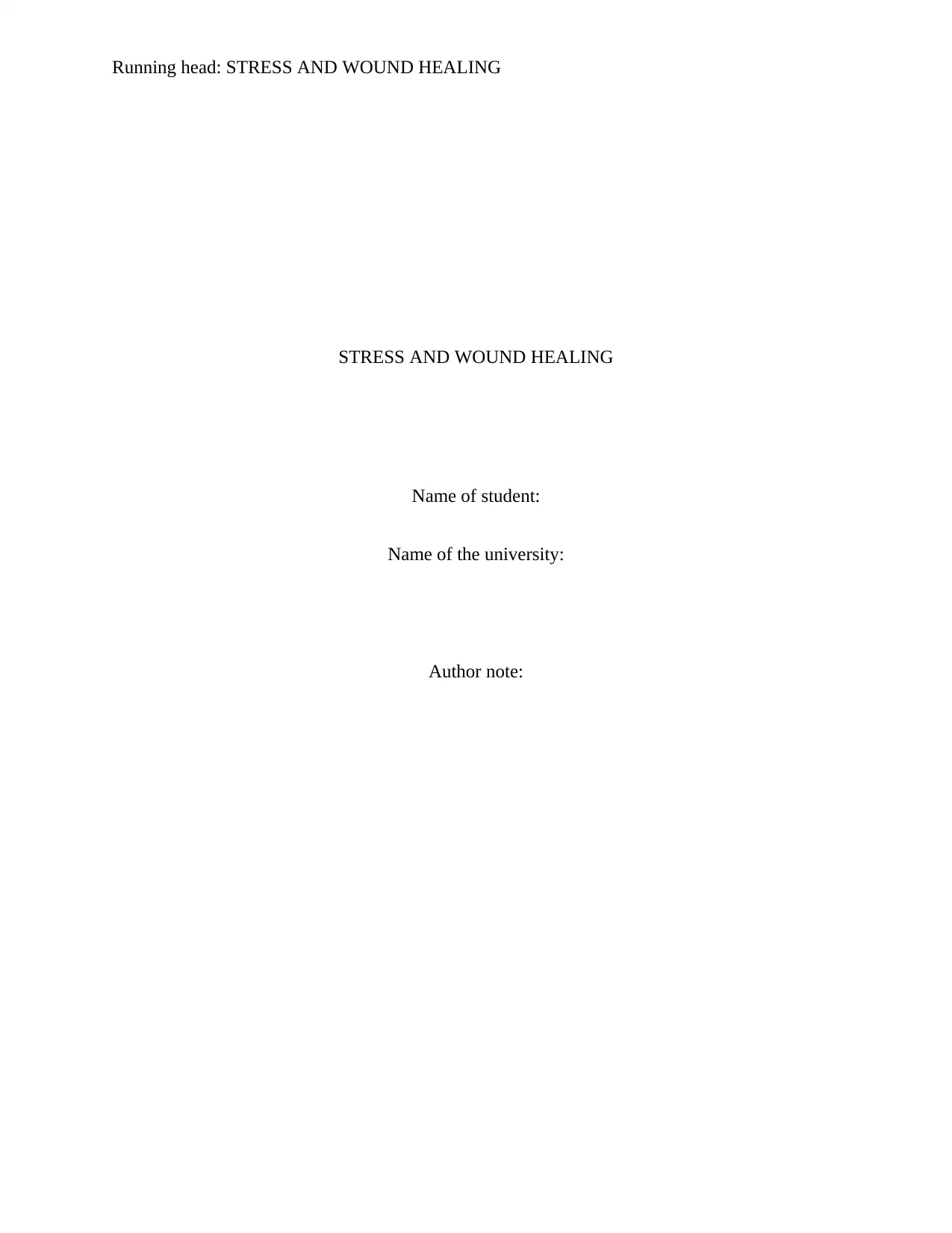
Running head: STRESS AND WOUND HEALING
STRESS AND WOUND HEALING
Name of student:
Name of the university:
Author note:
STRESS AND WOUND HEALING
Name of student:
Name of the university:
Author note:
Paraphrase This Document
Need a fresh take? Get an instant paraphrase of this document with our AI Paraphraser
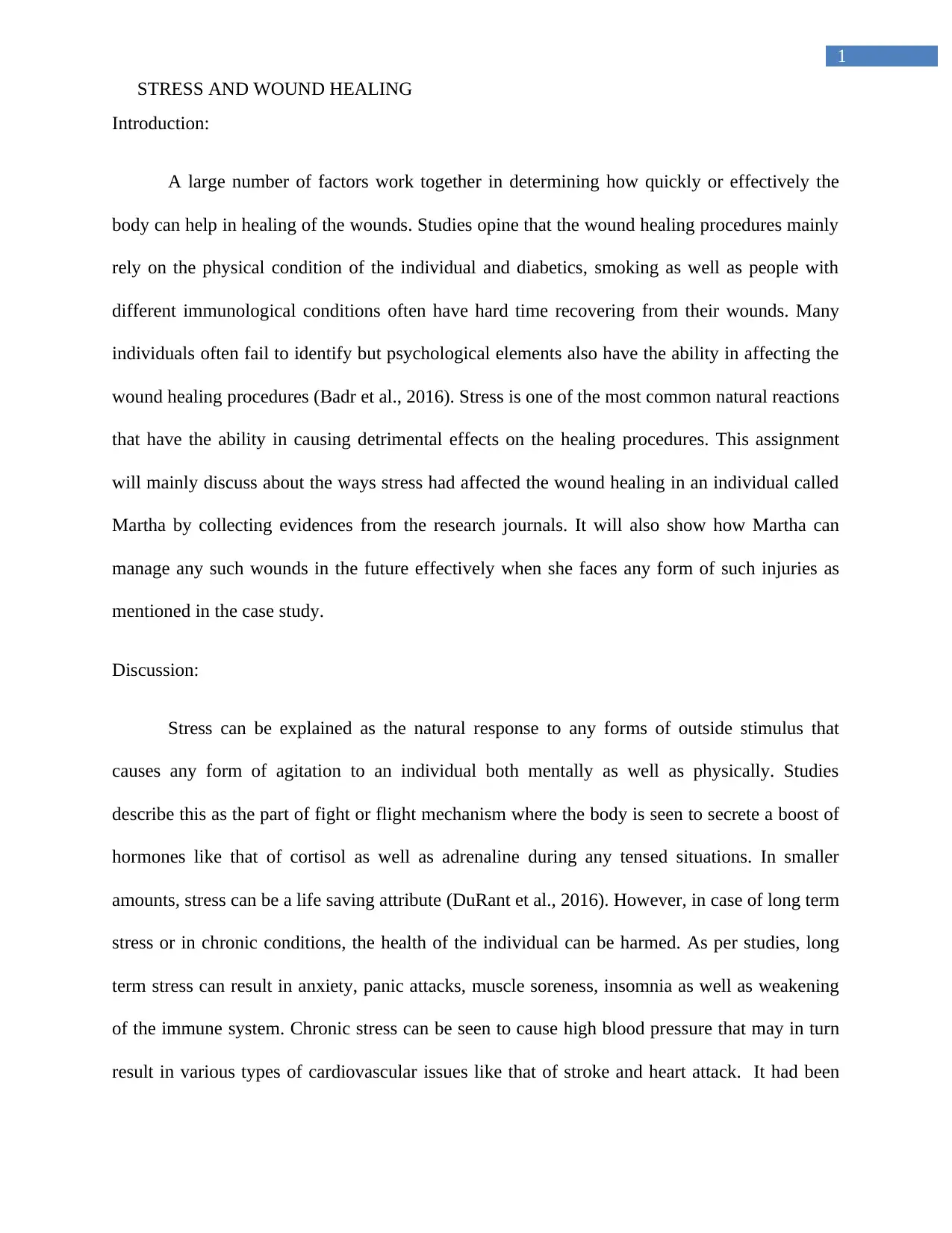
1
STRESS AND WOUND HEALING
Introduction:
A large number of factors work together in determining how quickly or effectively the
body can help in healing of the wounds. Studies opine that the wound healing procedures mainly
rely on the physical condition of the individual and diabetics, smoking as well as people with
different immunological conditions often have hard time recovering from their wounds. Many
individuals often fail to identify but psychological elements also have the ability in affecting the
wound healing procedures (Badr et al., 2016). Stress is one of the most common natural reactions
that have the ability in causing detrimental effects on the healing procedures. This assignment
will mainly discuss about the ways stress had affected the wound healing in an individual called
Martha by collecting evidences from the research journals. It will also show how Martha can
manage any such wounds in the future effectively when she faces any form of such injuries as
mentioned in the case study.
Discussion:
Stress can be explained as the natural response to any forms of outside stimulus that
causes any form of agitation to an individual both mentally as well as physically. Studies
describe this as the part of fight or flight mechanism where the body is seen to secrete a boost of
hormones like that of cortisol as well as adrenaline during any tensed situations. In smaller
amounts, stress can be a life saving attribute (DuRant et al., 2016). However, in case of long term
stress or in chronic conditions, the health of the individual can be harmed. As per studies, long
term stress can result in anxiety, panic attacks, muscle soreness, insomnia as well as weakening
of the immune system. Chronic stress can be seen to cause high blood pressure that may in turn
result in various types of cardiovascular issues like that of stroke and heart attack. It had been
STRESS AND WOUND HEALING
Introduction:
A large number of factors work together in determining how quickly or effectively the
body can help in healing of the wounds. Studies opine that the wound healing procedures mainly
rely on the physical condition of the individual and diabetics, smoking as well as people with
different immunological conditions often have hard time recovering from their wounds. Many
individuals often fail to identify but psychological elements also have the ability in affecting the
wound healing procedures (Badr et al., 2016). Stress is one of the most common natural reactions
that have the ability in causing detrimental effects on the healing procedures. This assignment
will mainly discuss about the ways stress had affected the wound healing in an individual called
Martha by collecting evidences from the research journals. It will also show how Martha can
manage any such wounds in the future effectively when she faces any form of such injuries as
mentioned in the case study.
Discussion:
Stress can be explained as the natural response to any forms of outside stimulus that
causes any form of agitation to an individual both mentally as well as physically. Studies
describe this as the part of fight or flight mechanism where the body is seen to secrete a boost of
hormones like that of cortisol as well as adrenaline during any tensed situations. In smaller
amounts, stress can be a life saving attribute (DuRant et al., 2016). However, in case of long term
stress or in chronic conditions, the health of the individual can be harmed. As per studies, long
term stress can result in anxiety, panic attacks, muscle soreness, insomnia as well as weakening
of the immune system. Chronic stress can be seen to cause high blood pressure that may in turn
result in various types of cardiovascular issues like that of stroke and heart attack. It had been
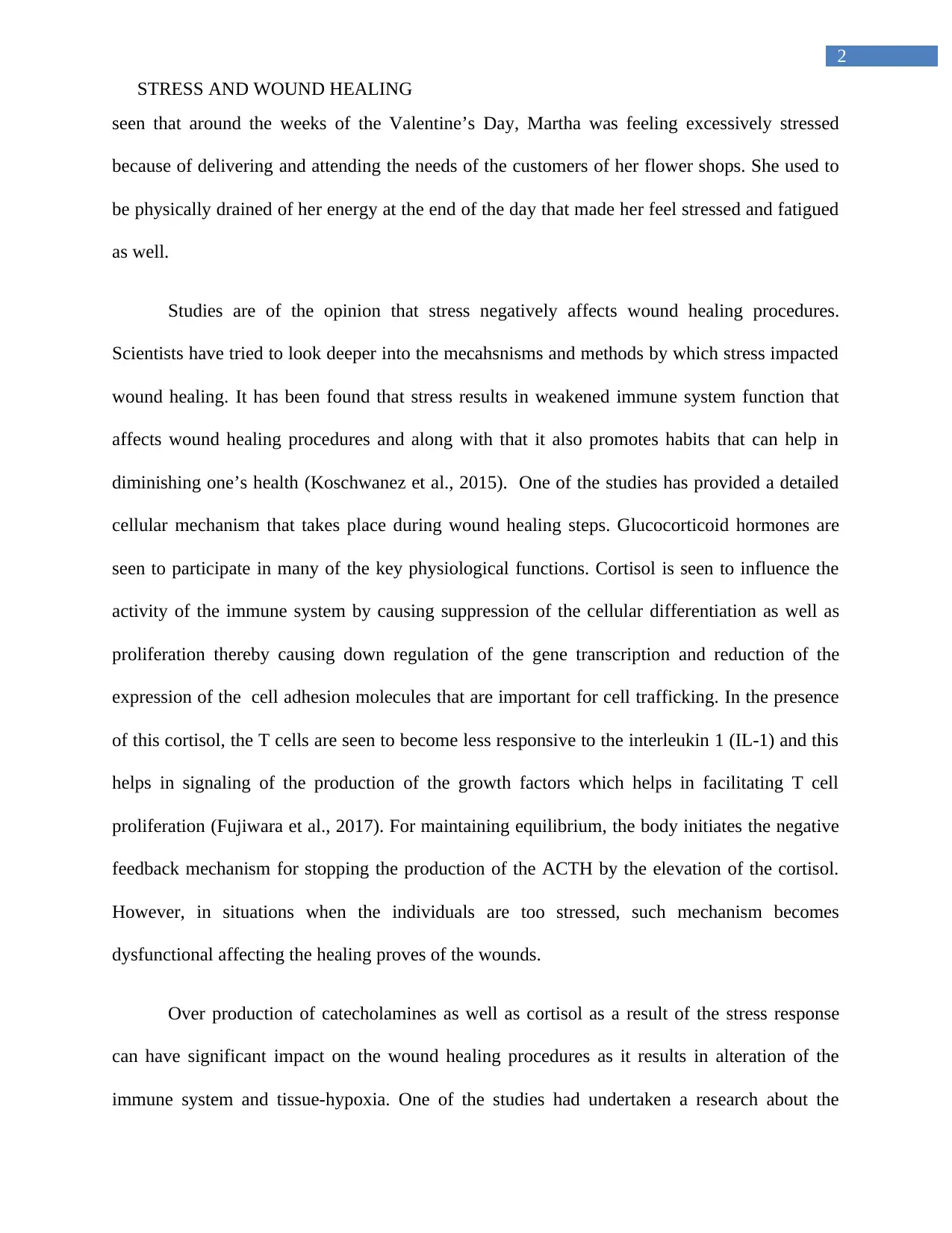
2
STRESS AND WOUND HEALING
seen that around the weeks of the Valentine’s Day, Martha was feeling excessively stressed
because of delivering and attending the needs of the customers of her flower shops. She used to
be physically drained of her energy at the end of the day that made her feel stressed and fatigued
as well.
Studies are of the opinion that stress negatively affects wound healing procedures.
Scientists have tried to look deeper into the mecahsnisms and methods by which stress impacted
wound healing. It has been found that stress results in weakened immune system function that
affects wound healing procedures and along with that it also promotes habits that can help in
diminishing one’s health (Koschwanez et al., 2015). One of the studies has provided a detailed
cellular mechanism that takes place during wound healing steps. Glucocorticoid hormones are
seen to participate in many of the key physiological functions. Cortisol is seen to influence the
activity of the immune system by causing suppression of the cellular differentiation as well as
proliferation thereby causing down regulation of the gene transcription and reduction of the
expression of the cell adhesion molecules that are important for cell trafficking. In the presence
of this cortisol, the T cells are seen to become less responsive to the interleukin 1 (IL-1) and this
helps in signaling of the production of the growth factors which helps in facilitating T cell
proliferation (Fujiwara et al., 2017). For maintaining equilibrium, the body initiates the negative
feedback mechanism for stopping the production of the ACTH by the elevation of the cortisol.
However, in situations when the individuals are too stressed, such mechanism becomes
dysfunctional affecting the healing proves of the wounds.
Over production of catecholamines as well as cortisol as a result of the stress response
can have significant impact on the wound healing procedures as it results in alteration of the
immune system and tissue-hypoxia. One of the studies had undertaken a research about the
STRESS AND WOUND HEALING
seen that around the weeks of the Valentine’s Day, Martha was feeling excessively stressed
because of delivering and attending the needs of the customers of her flower shops. She used to
be physically drained of her energy at the end of the day that made her feel stressed and fatigued
as well.
Studies are of the opinion that stress negatively affects wound healing procedures.
Scientists have tried to look deeper into the mecahsnisms and methods by which stress impacted
wound healing. It has been found that stress results in weakened immune system function that
affects wound healing procedures and along with that it also promotes habits that can help in
diminishing one’s health (Koschwanez et al., 2015). One of the studies has provided a detailed
cellular mechanism that takes place during wound healing steps. Glucocorticoid hormones are
seen to participate in many of the key physiological functions. Cortisol is seen to influence the
activity of the immune system by causing suppression of the cellular differentiation as well as
proliferation thereby causing down regulation of the gene transcription and reduction of the
expression of the cell adhesion molecules that are important for cell trafficking. In the presence
of this cortisol, the T cells are seen to become less responsive to the interleukin 1 (IL-1) and this
helps in signaling of the production of the growth factors which helps in facilitating T cell
proliferation (Fujiwara et al., 2017). For maintaining equilibrium, the body initiates the negative
feedback mechanism for stopping the production of the ACTH by the elevation of the cortisol.
However, in situations when the individuals are too stressed, such mechanism becomes
dysfunctional affecting the healing proves of the wounds.
Over production of catecholamines as well as cortisol as a result of the stress response
can have significant impact on the wound healing procedures as it results in alteration of the
immune system and tissue-hypoxia. One of the studies had undertaken a research about the
⊘ This is a preview!⊘
Do you want full access?
Subscribe today to unlock all pages.

Trusted by 1+ million students worldwide
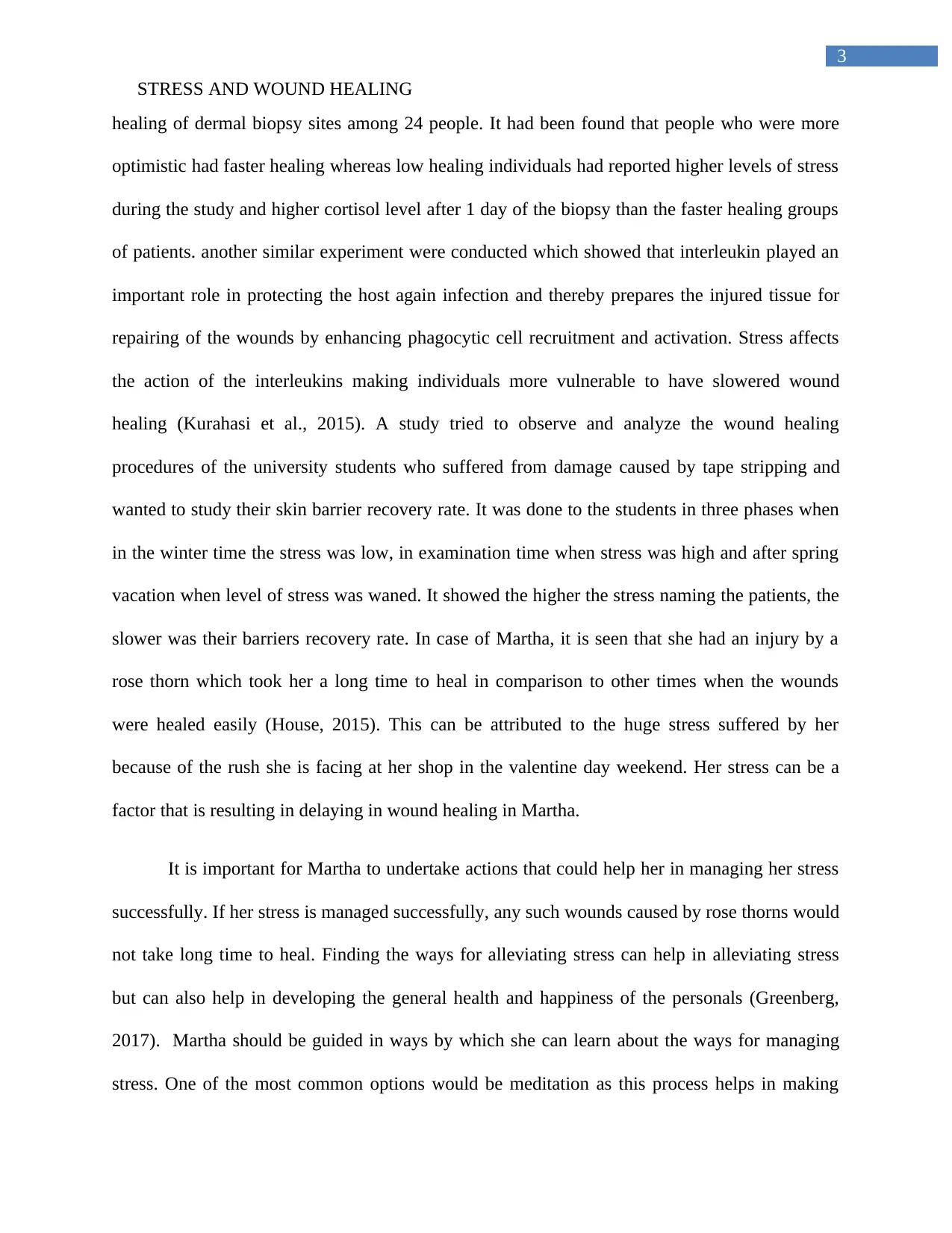
3
STRESS AND WOUND HEALING
healing of dermal biopsy sites among 24 people. It had been found that people who were more
optimistic had faster healing whereas low healing individuals had reported higher levels of stress
during the study and higher cortisol level after 1 day of the biopsy than the faster healing groups
of patients. another similar experiment were conducted which showed that interleukin played an
important role in protecting the host again infection and thereby prepares the injured tissue for
repairing of the wounds by enhancing phagocytic cell recruitment and activation. Stress affects
the action of the interleukins making individuals more vulnerable to have slowered wound
healing (Kurahasi et al., 2015). A study tried to observe and analyze the wound healing
procedures of the university students who suffered from damage caused by tape stripping and
wanted to study their skin barrier recovery rate. It was done to the students in three phases when
in the winter time the stress was low, in examination time when stress was high and after spring
vacation when level of stress was waned. It showed the higher the stress naming the patients, the
slower was their barriers recovery rate. In case of Martha, it is seen that she had an injury by a
rose thorn which took her a long time to heal in comparison to other times when the wounds
were healed easily (House, 2015). This can be attributed to the huge stress suffered by her
because of the rush she is facing at her shop in the valentine day weekend. Her stress can be a
factor that is resulting in delaying in wound healing in Martha.
It is important for Martha to undertake actions that could help her in managing her stress
successfully. If her stress is managed successfully, any such wounds caused by rose thorns would
not take long time to heal. Finding the ways for alleviating stress can help in alleviating stress
but can also help in developing the general health and happiness of the personals (Greenberg,
2017). Martha should be guided in ways by which she can learn about the ways for managing
stress. One of the most common options would be meditation as this process helps in making
STRESS AND WOUND HEALING
healing of dermal biopsy sites among 24 people. It had been found that people who were more
optimistic had faster healing whereas low healing individuals had reported higher levels of stress
during the study and higher cortisol level after 1 day of the biopsy than the faster healing groups
of patients. another similar experiment were conducted which showed that interleukin played an
important role in protecting the host again infection and thereby prepares the injured tissue for
repairing of the wounds by enhancing phagocytic cell recruitment and activation. Stress affects
the action of the interleukins making individuals more vulnerable to have slowered wound
healing (Kurahasi et al., 2015). A study tried to observe and analyze the wound healing
procedures of the university students who suffered from damage caused by tape stripping and
wanted to study their skin barrier recovery rate. It was done to the students in three phases when
in the winter time the stress was low, in examination time when stress was high and after spring
vacation when level of stress was waned. It showed the higher the stress naming the patients, the
slower was their barriers recovery rate. In case of Martha, it is seen that she had an injury by a
rose thorn which took her a long time to heal in comparison to other times when the wounds
were healed easily (House, 2015). This can be attributed to the huge stress suffered by her
because of the rush she is facing at her shop in the valentine day weekend. Her stress can be a
factor that is resulting in delaying in wound healing in Martha.
It is important for Martha to undertake actions that could help her in managing her stress
successfully. If her stress is managed successfully, any such wounds caused by rose thorns would
not take long time to heal. Finding the ways for alleviating stress can help in alleviating stress
but can also help in developing the general health and happiness of the personals (Greenberg,
2017). Martha should be guided in ways by which she can learn about the ways for managing
stress. One of the most common options would be meditation as this process helps in making
Paraphrase This Document
Need a fresh take? Get an instant paraphrase of this document with our AI Paraphraser
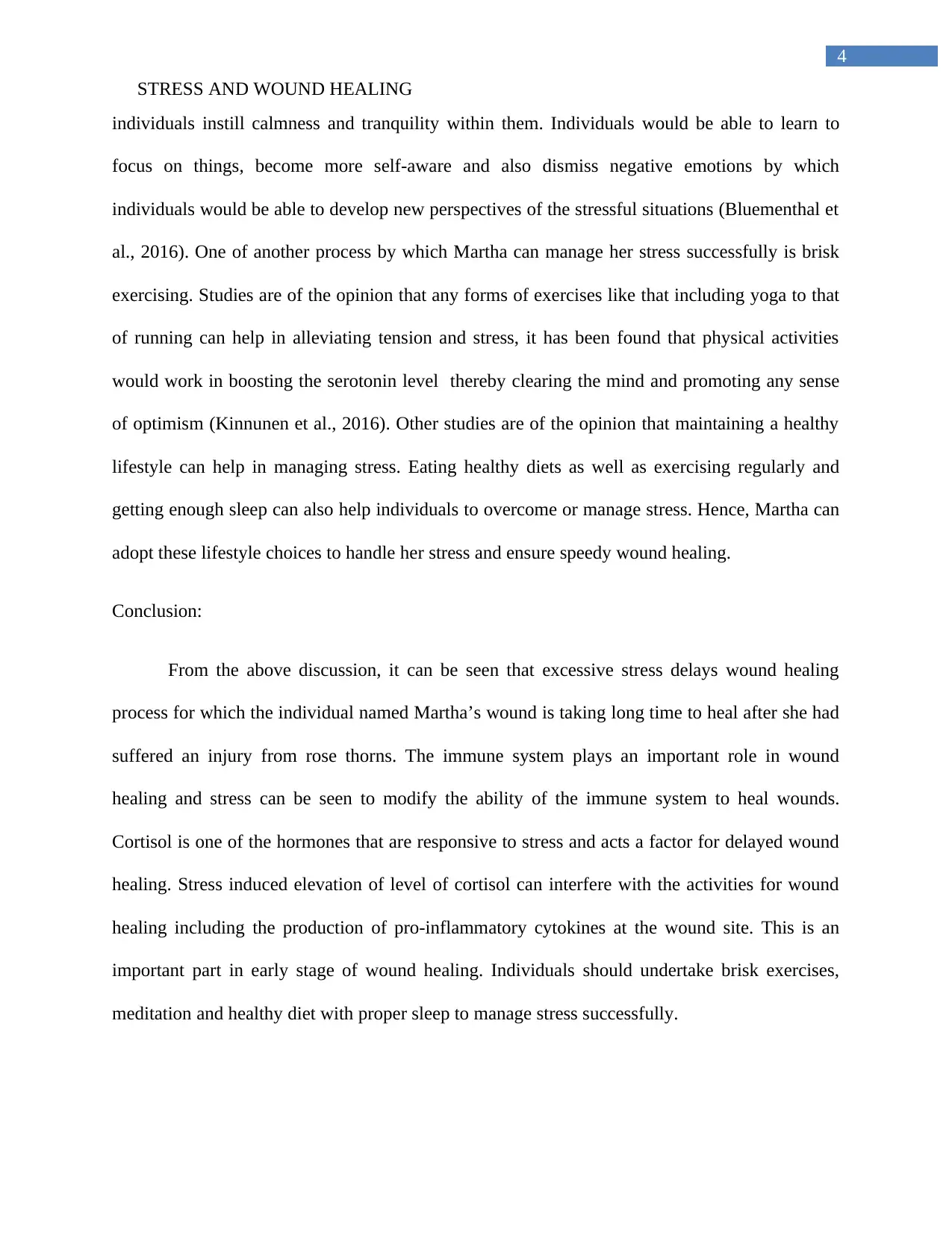
4
STRESS AND WOUND HEALING
individuals instill calmness and tranquility within them. Individuals would be able to learn to
focus on things, become more self-aware and also dismiss negative emotions by which
individuals would be able to develop new perspectives of the stressful situations (Bluementhal et
al., 2016). One of another process by which Martha can manage her stress successfully is brisk
exercising. Studies are of the opinion that any forms of exercises like that including yoga to that
of running can help in alleviating tension and stress, it has been found that physical activities
would work in boosting the serotonin level thereby clearing the mind and promoting any sense
of optimism (Kinnunen et al., 2016). Other studies are of the opinion that maintaining a healthy
lifestyle can help in managing stress. Eating healthy diets as well as exercising regularly and
getting enough sleep can also help individuals to overcome or manage stress. Hence, Martha can
adopt these lifestyle choices to handle her stress and ensure speedy wound healing.
Conclusion:
From the above discussion, it can be seen that excessive stress delays wound healing
process for which the individual named Martha’s wound is taking long time to heal after she had
suffered an injury from rose thorns. The immune system plays an important role in wound
healing and stress can be seen to modify the ability of the immune system to heal wounds.
Cortisol is one of the hormones that are responsive to stress and acts a factor for delayed wound
healing. Stress induced elevation of level of cortisol can interfere with the activities for wound
healing including the production of pro-inflammatory cytokines at the wound site. This is an
important part in early stage of wound healing. Individuals should undertake brisk exercises,
meditation and healthy diet with proper sleep to manage stress successfully.
STRESS AND WOUND HEALING
individuals instill calmness and tranquility within them. Individuals would be able to learn to
focus on things, become more self-aware and also dismiss negative emotions by which
individuals would be able to develop new perspectives of the stressful situations (Bluementhal et
al., 2016). One of another process by which Martha can manage her stress successfully is brisk
exercising. Studies are of the opinion that any forms of exercises like that including yoga to that
of running can help in alleviating tension and stress, it has been found that physical activities
would work in boosting the serotonin level thereby clearing the mind and promoting any sense
of optimism (Kinnunen et al., 2016). Other studies are of the opinion that maintaining a healthy
lifestyle can help in managing stress. Eating healthy diets as well as exercising regularly and
getting enough sleep can also help individuals to overcome or manage stress. Hence, Martha can
adopt these lifestyle choices to handle her stress and ensure speedy wound healing.
Conclusion:
From the above discussion, it can be seen that excessive stress delays wound healing
process for which the individual named Martha’s wound is taking long time to heal after she had
suffered an injury from rose thorns. The immune system plays an important role in wound
healing and stress can be seen to modify the ability of the immune system to heal wounds.
Cortisol is one of the hormones that are responsive to stress and acts a factor for delayed wound
healing. Stress induced elevation of level of cortisol can interfere with the activities for wound
healing including the production of pro-inflammatory cytokines at the wound site. This is an
important part in early stage of wound healing. Individuals should undertake brisk exercises,
meditation and healthy diet with proper sleep to manage stress successfully.
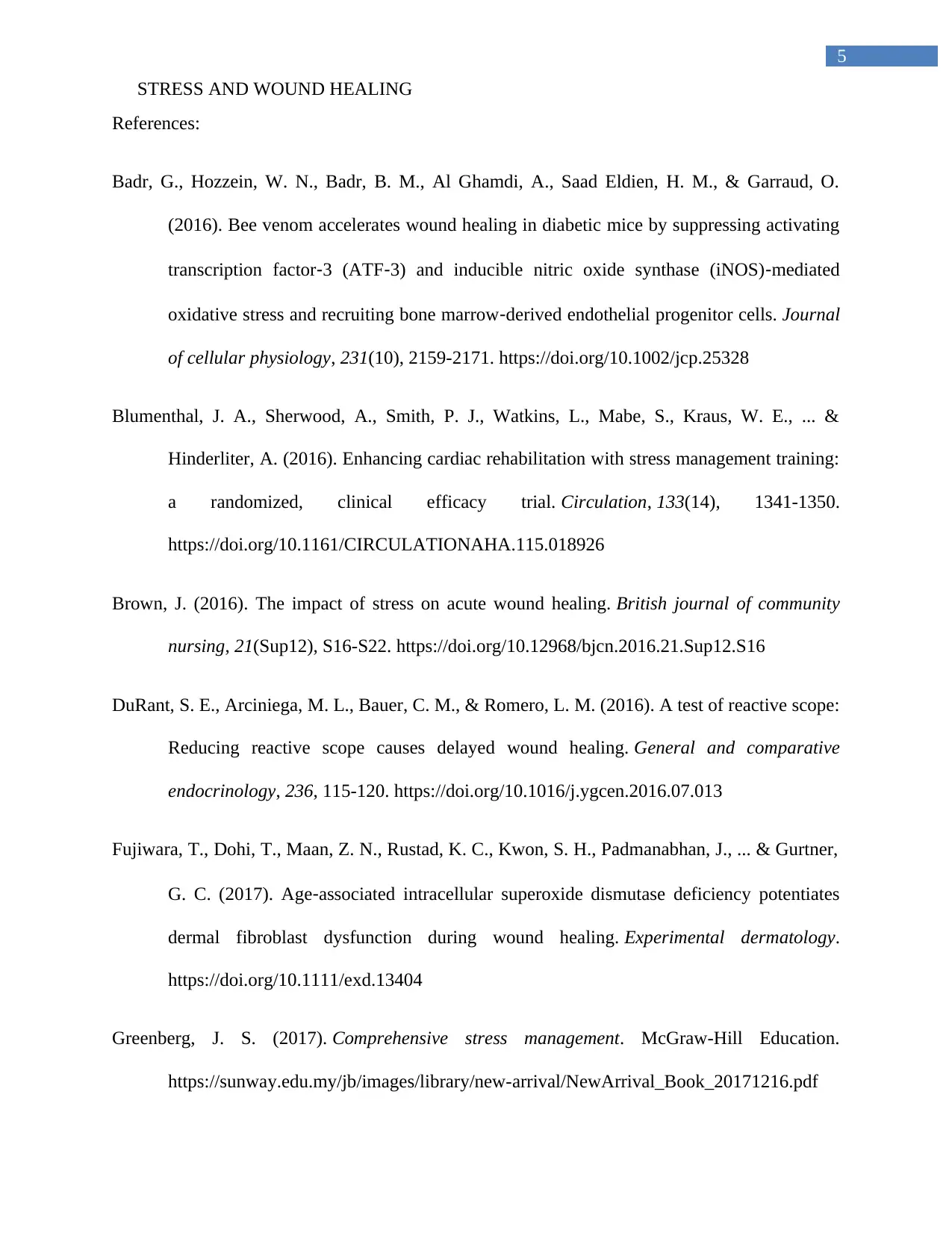
5
STRESS AND WOUND HEALING
References:
Badr, G., Hozzein, W. N., Badr, B. M., Al Ghamdi, A., Saad Eldien, H. M., & Garraud, O.
(2016). Bee venom accelerates wound healing in diabetic mice by suppressing activating
transcription factor‐3 (ATF‐3) and inducible nitric oxide synthase (iNOS)‐mediated
oxidative stress and recruiting bone marrow‐derived endothelial progenitor cells. Journal
of cellular physiology, 231(10), 2159-2171. https://doi.org/10.1002/jcp.25328
Blumenthal, J. A., Sherwood, A., Smith, P. J., Watkins, L., Mabe, S., Kraus, W. E., ... &
Hinderliter, A. (2016). Enhancing cardiac rehabilitation with stress management training:
a randomized, clinical efficacy trial. Circulation, 133(14), 1341-1350.
https://doi.org/10.1161/CIRCULATIONAHA.115.018926
Brown, J. (2016). The impact of stress on acute wound healing. British journal of community
nursing, 21(Sup12), S16-S22. https://doi.org/10.12968/bjcn.2016.21.Sup12.S16
DuRant, S. E., Arciniega, M. L., Bauer, C. M., & Romero, L. M. (2016). A test of reactive scope:
Reducing reactive scope causes delayed wound healing. General and comparative
endocrinology, 236, 115-120. https://doi.org/10.1016/j.ygcen.2016.07.013
Fujiwara, T., Dohi, T., Maan, Z. N., Rustad, K. C., Kwon, S. H., Padmanabhan, J., ... & Gurtner,
G. C. (2017). Age‐associated intracellular superoxide dismutase deficiency potentiates
dermal fibroblast dysfunction during wound healing. Experimental dermatology.
https://doi.org/10.1111/exd.13404
Greenberg, J. S. (2017). Comprehensive stress management. McGraw-Hill Education.
https://sunway.edu.my/jb/images/library/new-arrival/NewArrival_Book_20171216.pdf
STRESS AND WOUND HEALING
References:
Badr, G., Hozzein, W. N., Badr, B. M., Al Ghamdi, A., Saad Eldien, H. M., & Garraud, O.
(2016). Bee venom accelerates wound healing in diabetic mice by suppressing activating
transcription factor‐3 (ATF‐3) and inducible nitric oxide synthase (iNOS)‐mediated
oxidative stress and recruiting bone marrow‐derived endothelial progenitor cells. Journal
of cellular physiology, 231(10), 2159-2171. https://doi.org/10.1002/jcp.25328
Blumenthal, J. A., Sherwood, A., Smith, P. J., Watkins, L., Mabe, S., Kraus, W. E., ... &
Hinderliter, A. (2016). Enhancing cardiac rehabilitation with stress management training:
a randomized, clinical efficacy trial. Circulation, 133(14), 1341-1350.
https://doi.org/10.1161/CIRCULATIONAHA.115.018926
Brown, J. (2016). The impact of stress on acute wound healing. British journal of community
nursing, 21(Sup12), S16-S22. https://doi.org/10.12968/bjcn.2016.21.Sup12.S16
DuRant, S. E., Arciniega, M. L., Bauer, C. M., & Romero, L. M. (2016). A test of reactive scope:
Reducing reactive scope causes delayed wound healing. General and comparative
endocrinology, 236, 115-120. https://doi.org/10.1016/j.ygcen.2016.07.013
Fujiwara, T., Dohi, T., Maan, Z. N., Rustad, K. C., Kwon, S. H., Padmanabhan, J., ... & Gurtner,
G. C. (2017). Age‐associated intracellular superoxide dismutase deficiency potentiates
dermal fibroblast dysfunction during wound healing. Experimental dermatology.
https://doi.org/10.1111/exd.13404
Greenberg, J. S. (2017). Comprehensive stress management. McGraw-Hill Education.
https://sunway.edu.my/jb/images/library/new-arrival/NewArrival_Book_20171216.pdf
⊘ This is a preview!⊘
Do you want full access?
Subscribe today to unlock all pages.

Trusted by 1+ million students worldwide
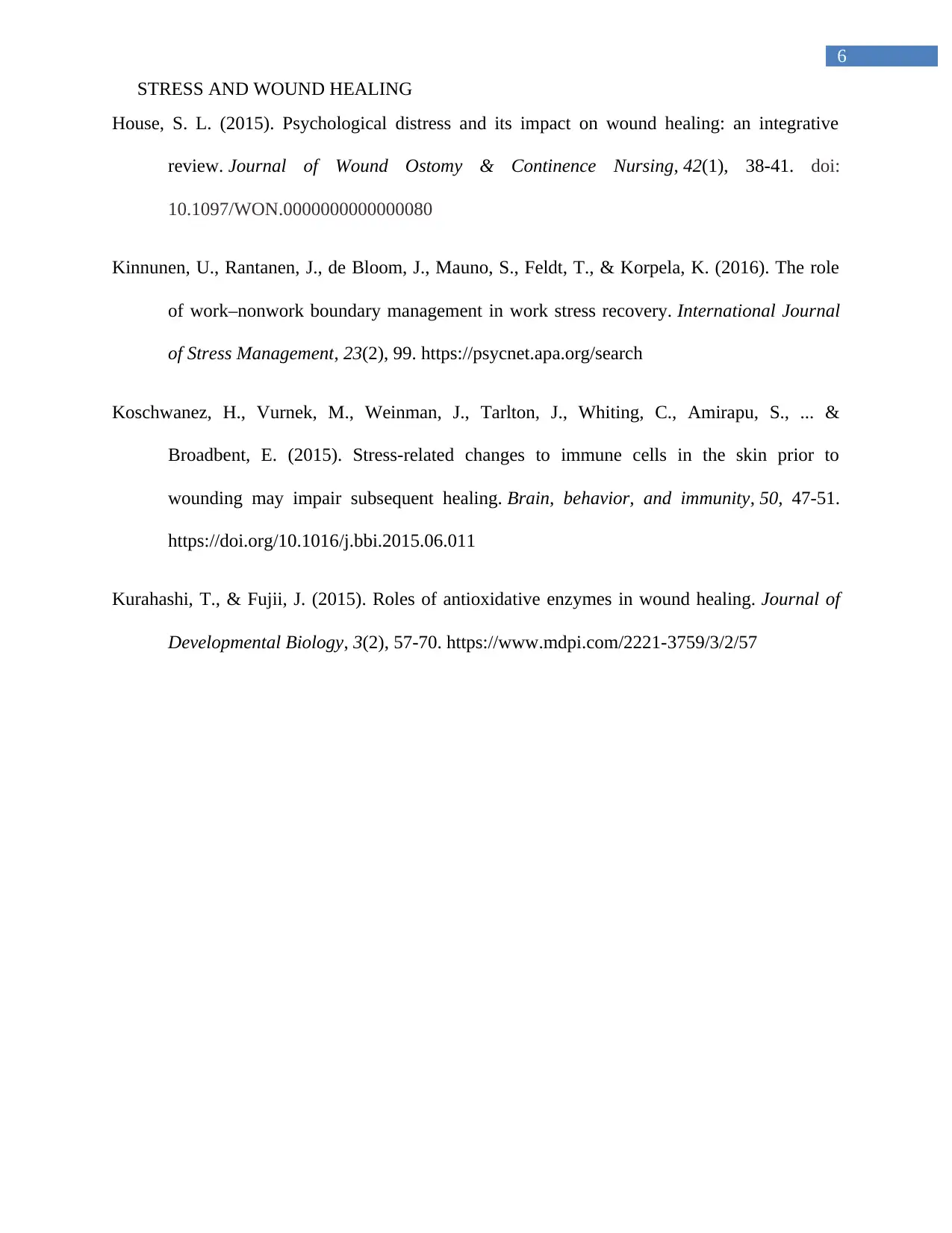
6
STRESS AND WOUND HEALING
House, S. L. (2015). Psychological distress and its impact on wound healing: an integrative
review. Journal of Wound Ostomy & Continence Nursing, 42(1), 38-41. doi:
10.1097/WON.0000000000000080
Kinnunen, U., Rantanen, J., de Bloom, J., Mauno, S., Feldt, T., & Korpela, K. (2016). The role
of work–nonwork boundary management in work stress recovery. International Journal
of Stress Management, 23(2), 99. https://psycnet.apa.org/search
Koschwanez, H., Vurnek, M., Weinman, J., Tarlton, J., Whiting, C., Amirapu, S., ... &
Broadbent, E. (2015). Stress-related changes to immune cells in the skin prior to
wounding may impair subsequent healing. Brain, behavior, and immunity, 50, 47-51.
https://doi.org/10.1016/j.bbi.2015.06.011
Kurahashi, T., & Fujii, J. (2015). Roles of antioxidative enzymes in wound healing. Journal of
Developmental Biology, 3(2), 57-70. https://www.mdpi.com/2221-3759/3/2/57
STRESS AND WOUND HEALING
House, S. L. (2015). Psychological distress and its impact on wound healing: an integrative
review. Journal of Wound Ostomy & Continence Nursing, 42(1), 38-41. doi:
10.1097/WON.0000000000000080
Kinnunen, U., Rantanen, J., de Bloom, J., Mauno, S., Feldt, T., & Korpela, K. (2016). The role
of work–nonwork boundary management in work stress recovery. International Journal
of Stress Management, 23(2), 99. https://psycnet.apa.org/search
Koschwanez, H., Vurnek, M., Weinman, J., Tarlton, J., Whiting, C., Amirapu, S., ... &
Broadbent, E. (2015). Stress-related changes to immune cells in the skin prior to
wounding may impair subsequent healing. Brain, behavior, and immunity, 50, 47-51.
https://doi.org/10.1016/j.bbi.2015.06.011
Kurahashi, T., & Fujii, J. (2015). Roles of antioxidative enzymes in wound healing. Journal of
Developmental Biology, 3(2), 57-70. https://www.mdpi.com/2221-3759/3/2/57
1 out of 7
Related Documents
Your All-in-One AI-Powered Toolkit for Academic Success.
+13062052269
info@desklib.com
Available 24*7 on WhatsApp / Email
![[object Object]](/_next/static/media/star-bottom.7253800d.svg)
Unlock your academic potential
Copyright © 2020–2025 A2Z Services. All Rights Reserved. Developed and managed by ZUCOL.





